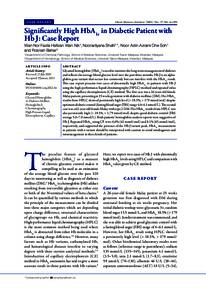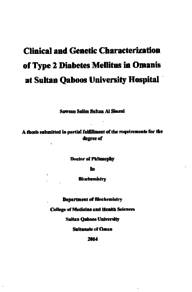Document
The association of glycated hemoglobin with metabolic risk factors and antioxidants in Omani healthy adults
Publisher
Sultan Qaboos University
Gregorian
2014
Language
English
English abstract
Background: Diabetes mellitus (DM) is a common metabolic disease characterized by hyperglycemia and insufficiency of insulin secretion, insulin action or both. Uncontrolled hyperglycemia contributes to increased glycation end products that exacerbate oxidative stress. Increasing evidence indicate that repeated acute changes in glucose metabolism, or long-term accumulation of glycated biomolecules contribute to mitochondrial dysfunction that promote accumulation of reactive oxygen species (ROS), leading to micro-vascular and macro-vascular complications. However, glycooxidative stress may not only be limited to pathological diabetes, it is also a major concern in civilized societies where humans are continuously in a postprandial state, usually consuming readily available energy rich meals aggravated by a sedentary lifestyle. Therefore, this persistent glycemic status reflected by glycated hemoglobin (HbA1c) may provide useful parameters to investigate the association of glycemic status with different metabolic and anti-oxidant parameters in healthy adults.
Aim: The main aim of this study is to investigate the association of glycated hemoglobin (HbA1c) with different anthropometric, metabolic and antioxidant parameters in healthy Omani adults.
Subjects and methods: This is a prospective study involving 106 apparently healthy adults (53 males and 53 females), age range (18 - 40 years). The subjects are nondiabetes with or without family history of diabetes. In this study EDTA-whole blood was used for glycated hemoglobin (HbAlc %) measurement by biochemistry analyzer (COBAS® INTEGRA 400 plus, Roche). Plasma samples were used to measure metabolic parameters by biochemistry analyzer (COBAS c111, Roche Diagnostics). Serum antioxidants markers were determined using commercial kits
(Rio Vision, USA). Finally, all the data obtained were analyzed by the SPSS a I version 22.
Results: we found significant positive correlations of HbAlc with metabolic risk factors namely age, BMI, WST, GGT, total cholesterol and non-HDL cholesterol. However, HbAlc had no significant correlation with serum antioxidant parameters. In addition, we observe significant higher HbA1c level (P = 0.02) in subject with diabetes family history versus subjects without diabetes family history. Multiple linear regression analysis revealed that GGT is the main independent predictor of HbAlc (Adjusted R-square= 0.138, B= 0.383). Interestingly, we found strong positive correlations of GGT with metabolic risk factors (age, BMI, WST, total cholesterol, and non-HDL cholesterol). In addition, GGT shows inverse correlation with total antioxidant capacity (r = -0.471, P<0.0001) and HDL-C level (r= -0.435, P<0.0001).
Conclusion: we found that HbA1c level is determined mainly by GGT activity. In addition, GGT show a significant positive correlation with metabolic risk factors and significant inverse relation with total antioxidant capacity (TAC). These results may expand the clinical importance of GGT as an early marker of risk factors and may provide a link between diabetes and oxidative stress which may explain its role in the development and progression of diabetes.
Key words: glycated hemoglobin, metabolic syndrome, diabetes mellitus, antioxidants.
Member of
Resource URL
Arabic abstract
خلفية: داء السكري هو مرض ايضي شائع يتميز بارتفاع السكر في الدم وعدم كفاية افراز الأنسولين أو عمل الأنسولين أو كليهما. ارتفاع السكر في الدم الغير المنظبط يسهم في زيادة منتجات الدم السكرية النهائية (AGE) التي تفاقم الأكسده. هناك أدله متزایده تشير الى أن التغيرات الحاده المتكرره في ايض الجلوكوز أوالتراكم الطويل الأجل من الجزيئات الحيوية السكرية قد تساهم في ضعف وظائف الميتوكندريا و تراكم جزيئات الأكسجين التفاعلية (ROS) مما يؤدي إلى مضاعفات في الأوعية الدموية. ومع ذلك فان الإجهاد السكري قد لا يقتصر على مرض السكري , بل هو أيضا مصدر قلق كبير حيث أن الناس عادة ما يستهلكون الوجبات المتاحة الغنية بالطاقة مع تفاقم الخمول في نمط الحياه العصريه لذلك فان وضع نسبة السكر في الدم التي يعكسها الهيموجلوبين السكري (HbA1c) قد توفر علامات مفيده لفحص العلاقه بين الهيموجلوبين السكري مع عوامل الأيض المختلفة و مضادات الأكسده في البالغين الأصحاء.
المشاركين والخطوات العملية : هي دراسة استطلاعية تشمل (106) من الأشخاص البالغين الأصحاء ظاهريا (53 ذكور و 53 إناث) و الفئة العمرية (18- 40 سنة). غير مصابين بمرض السكري مع أو بدون تاریخ عائلي لمرض السكري . في هذه الدراسة تم استخدام عينات الدم لقياس الهيموجلوبين السكري (HbA1c) بواسطة جهاز الكيمياء الحيوية (COBAS INTEGRA 400 plus , Roche ) وتم استخدام عينات البلازما الاجراء فحوصات الأيض بواسطة جهاز (COBAS c111 , Roche ) وتم قیاس مضادات الأكسده في مصل الدم باستخدام (Bio Vision , USA ) . واخيرا تم تحليل البيانات باستخدام برنامج ( 22 SPSS version) . النتائج : وجدنا ارتباطات إيجابية قوية بين نسبة الهيموجلوبين السكري وعوامل الخطر الأيضية وهي (العمري مؤشر كتلة الجسم محيط الخصر, GGT الكولسترول الكلي و non - HDL cholesterol). ولكن الهيموجلوبين السكري ليس له ارتباط قوي مع مضادات الأكسدة في مصل الدم . بالإضافة إلى ذلك لاحظنا ارتفاع مستوى نسبة الهيموجلوبين السكري في الأشخاص الذين لهم تاريخ عائلي لمرض السكري مقارنة بالذين ليس لهم تاريخ عائلي للمرض ( 0 . 02 = P). وكشفت الدراسة أن (GGT) هو العامل الرئيسي الذي يحدد الهيموجلوبين السكري ( 0 . 383 = 8 , 0 . 138 =Adjusted R - Square ) ومن المثير للإهتمام أن (GGT) له ارتباطات ايجابية قوية مع عوامل الخطر الأيضية مثل (العمر, مؤشر كتلة الجسم , محيط الخصر, الكولسترول الكلي و non - HDL cholesterol). و يظهر (GGT) علاقة عكسية مع اجمالي مضادات الاكسده ( 0 . 0001> r = - 0 . 471 , P ) و (r = - 0 . 435 , P < 0 . 0001 ) ( HDL - C).
الخاتمة : كشفت هذه الدراسة أن انزیم ('GGT) هو العامل الرئيسي الذي يحدد نسبة الهيموجلوبين السكري . وبالإضافة إلى ذلك , فإن (GGT) له ارتباط ایجابي قوي مع عوامل الخطر الأيضية وعلاقة عكسية قوية مع إجمالي مضادات الأكسدة (TAC). هذه النتائج قد توسع الأهمية السريرية ل ( GGT) كعلامة من عوامل الخطر المبكره ويمكن أن يوفر صلة بين مرض السكري والإجهاد التأكسدي وهو ما قد يفسر دور (GGT) في تطور وتقدم مرض السكري.
المشاركين والخطوات العملية : هي دراسة استطلاعية تشمل (106) من الأشخاص البالغين الأصحاء ظاهريا (53 ذكور و 53 إناث) و الفئة العمرية (18- 40 سنة). غير مصابين بمرض السكري مع أو بدون تاریخ عائلي لمرض السكري . في هذه الدراسة تم استخدام عينات الدم لقياس الهيموجلوبين السكري (HbA1c) بواسطة جهاز الكيمياء الحيوية (COBAS INTEGRA 400 plus , Roche ) وتم استخدام عينات البلازما الاجراء فحوصات الأيض بواسطة جهاز (COBAS c111 , Roche ) وتم قیاس مضادات الأكسده في مصل الدم باستخدام (Bio Vision , USA ) . واخيرا تم تحليل البيانات باستخدام برنامج ( 22 SPSS version) . النتائج : وجدنا ارتباطات إيجابية قوية بين نسبة الهيموجلوبين السكري وعوامل الخطر الأيضية وهي (العمري مؤشر كتلة الجسم محيط الخصر, GGT الكولسترول الكلي و non - HDL cholesterol). ولكن الهيموجلوبين السكري ليس له ارتباط قوي مع مضادات الأكسدة في مصل الدم . بالإضافة إلى ذلك لاحظنا ارتفاع مستوى نسبة الهيموجلوبين السكري في الأشخاص الذين لهم تاريخ عائلي لمرض السكري مقارنة بالذين ليس لهم تاريخ عائلي للمرض ( 0 . 02 = P). وكشفت الدراسة أن (GGT) هو العامل الرئيسي الذي يحدد الهيموجلوبين السكري ( 0 . 383 = 8 , 0 . 138 =Adjusted R - Square ) ومن المثير للإهتمام أن (GGT) له ارتباطات ايجابية قوية مع عوامل الخطر الأيضية مثل (العمر, مؤشر كتلة الجسم , محيط الخصر, الكولسترول الكلي و non - HDL cholesterol). و يظهر (GGT) علاقة عكسية مع اجمالي مضادات الاكسده ( 0 . 0001> r = - 0 . 471 , P ) و (r = - 0 . 435 , P < 0 . 0001 ) ( HDL - C).
الخاتمة : كشفت هذه الدراسة أن انزیم ('GGT) هو العامل الرئيسي الذي يحدد نسبة الهيموجلوبين السكري . وبالإضافة إلى ذلك , فإن (GGT) له ارتباط ایجابي قوي مع عوامل الخطر الأيضية وعلاقة عكسية قوية مع إجمالي مضادات الأكسدة (TAC). هذه النتائج قد توسع الأهمية السريرية ل ( GGT) كعلامة من عوامل الخطر المبكره ويمكن أن يوفر صلة بين مرض السكري والإجهاد التأكسدي وهو ما قد يفسر دور (GGT) في تطور وتقدم مرض السكري.
Category
Theses and Dissertations







